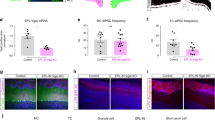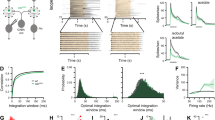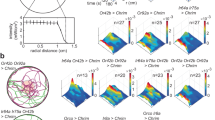Abstract
The responses of olfactory receptor neurons (ORNs) to odors have complex dynamics. Using genetics and pharmacology, we found that these dynamics in Drosophila ORNs could be separated into sequential steps, corresponding to transduction and spike generation. Each of these steps contributed distinct dynamics. Transduction dynamics could be largely explained by a simple kinetic model of ligand-receptor interactions, together with an adaptive feedback mechanism that slows transduction onset. Spiking dynamics were well described by a differentiating linear filter that was stereotyped across odors and cells. Genetic knock-down of sodium channels reshaped this filter, implying that it arises from the regulated balance of intrinsic conductances in ORNs. Complex responses can be understood as a consequence of how the stereotyped spike filter interacts with odor- and receptor-specific transduction dynamics. However, in the presence of rapidly fluctuating natural stimuli, spiking simply increases the speed and sensitivity of encoding.
This is a preview of subscription content, access via your institution
Access options
Subscribe to this journal
Receive 12 print issues and online access
$209.00 per year
only $17.42 per issue
Buy this article
- Purchase on Springer Link
- Instant access to full article PDF
Prices may be subject to local taxes which are calculated during checkout








Similar content being viewed by others
References
Murlis, J., Elkinton, J.S. & Cardé, R.T. Odor plumes and how insects use them. Annu. Rev. Entomol. 37, 505–532 (1992).
Vickers, N.J., Christensen, T.A., Baker, T.C. & Hildebrand, J.G. Odour-plume dynamics influence the brain's olfactory code. Nature 410, 466–470 (2001).
Kang, J. & Caprio, J. Electrophysiological responses of single olfactory bulb neurons to binary mixtures of amino acids in the channel catfish, Ictalurus punctatus. J. Neurophysiol. 74, 1435–1443 (1995).
de Bruyne, M., Clyne, P.J. & Carlson, J.R. Odor coding in a model olfactory organ: the Drosophila maxillary palp. J. Neurosci. 19, 4520–4532 (1999).
Reisert, J. & Matthews, H.R. Adaptation of the odour-induced response in frog olfactory receptor cells. J. Physiol. (Lond.) 519, 801–813 (1999).
de Bruyne, M., Foster, K. & Carlson, J.R. Odor coding in the Drosophila antenna. Neuron 30, 537–552 (2001).
Störtkuhl, K.F., Hovemann, B.T. & Carlson, J.R. Olfactory adaptation depends on the Trp Ca2+ channel in Drosophila. J. Neurosci. 19, 4839–4846 (1999).
Gu, Y., Lucas, P. & Rospars, J.P. Computational model of the insect pheromone transduction cascade. PLOS Comput. Biol. 5, e1000321 (2009).
Flecke, C. & Stengl, M. Octopamine and tyramine modulate pheromone-sensitive olfactory sensilla of the hawkmoth Manduca sexta in a time-dependent manner. J. Comp. Physiol. A Neuroethol. Sens. Neural Behav. Physiol. 195, 529–545 (2009).
Kaissling, K.E. Flux detectors versus concentration detectors: two types of chemoreceptors. Chem. Senses 23, 99–111 (1998).
Hallem, E.A., Ho, M.G. & Carlson, J.R. The molecular basis of odor coding in the Drosophila antenna. Cell 117, 965–979 (2004).
Sato, K. et al. Insect olfactory receptors are heteromeric ligand-gated ion channels. Nature 452, 1002–1006 (2008).
Benton, R., Sachse, S., Michnick, S.W. & Vosshall, L.B. Atypical membrane topology and heteromeric function of Drosophila odorant receptors in vivo. PLoS Biol. 4, e20 (2006).
Yao, C.A. & Carlson, J.R. Role of G proteins in odor-sensing and CO2-sensing neurons in Drosophila. J. Neurosci. 30, 4562–4572 (2010).
Wicher, D. et al. Drosophila odorant receptors are both ligand-gated and cyclic-nucleotide-activated cation channels. Nature 452, 1007–1011 (2008).
Schuckel, J., Torkkeli, P.H. & French, A.S. Two interacting olfactory transduction mechanisms have linked polarities and dynamics in Drosophila melanogaster antennal basiconic sensilla neurons. J. Neurophysiol. 102, 214–223 (2009).
Dobritsa, A.A., van der Goes van Naters, W., Warr, C.G., Steinbrecht, R.A. & Carlson, J.R. Integrating the molecular and cellular basis of odor coding in the Drosophila antenna. Neuron 37, 827–841 (2003).
Goldman, A.L., van der Goes van Naters, W., Lessing, D., Warr, C.G. & Carlson, J.R. Coexpression of two functional odor receptors in one neuron. Neuron 45, 661–666 (2005).
Johnston, D. & Wu, S.M.-S. Foundations of Cellular Neurophysiology (MIT Press, 1995).
Kaissling, K.E. Chemo-electrical transduction in insect olfactory receptors. Annu. Rev. Neurosci. 9, 121–145 (1986).
Schneider, D. Insect olfaction: deciphering system for chemical messages. Science 163, 1031–1037 (1969).
Baccus, S.A. & Meister, M. Fast and slow contrast adaptation in retinal circuitry. Neuron 36, 909–919 (2002).
Nagel, K.I. & Doupe, A.J. Temporal processing and adaptation in the songbird auditory forebrain. Neuron 51, 845–859 (2006).
Kim, A.J., Lazar, A.A. & Slutskiy, Y.B. System identification of Drosophila olfactory sensory neurons. J. Comput. Neurosci. published online doi:10.1007/s10827-010-0265-0 (21 August 2010).
Lundstrom, B.N., Hong, S., Higgs, M.H. & Fairhall, A.L. Two computational regimes of a single-compartment neuron separated by a planar boundary in conductance space. Neural Comput. 20, 1239–1260 (2008).
Hallem, E.A. & Carlson, J.R. Coding of odors by a receptor repertoire. Cell 125, 143–160 (2006).
Geffen, M.N., Broome, B.M., Laurent, G. & Meister, M. Neural encoding of rapidly fluctuating odors. Neuron 61, 570–586 (2009).
Rushton, W.A. Pigments and signals in colour vision. J. Physiol. 220, 1P–P (1972).
Laurent, G., Wehr, M. & Davidowitz, H. Temporal representations of odors in an olfactory network. J. Neurosci. 16, 3837–3847 (1996).
Daly, K.C., Wright, G.A. & Smith, B.H. Molecular features of odorants systematically influence slow temporal responses across clusters of coordinated antennal lobe units in the moth Manduca sexta. J. Neurophysiol. 92, 236–254 (2004).
Stopfer, M., Jayaraman, V. & Laurent, G. Intensity versus identity coding in an olfactory system. Neuron 39, 991–1004 (2003).
Raman, B., Joseph, J., Tang, J. & Stopfer, M. Temporally diverse firing patterns in olfactory receptor neurons underlie spatiotemporal neural codes for odors. J. Neurosci. 30, 1994–2006 (2010).
Soo, F.S., Detwiler, P.B. & Rieke, F. Light adaptation in salamander L-cone photoreceptors. J. Neurosci. 28, 1331–1342 (2008).
Deshpande, M., Venkatesh, K., Rodrigues, V. & Hasan, G. The inositol 1,4,5-trisphosphate receptor is required for maintenance of olfactory adaptation in Drosophila antennae. J. Neurobiol. 43, 282–288 (2000).
Neuhaus, E.M. et al. Odorant receptor heterodimerization in the olfactory system of Drosophila melanogaster. Nat. Neurosci. 8, 15–17 (2005).
Liu, M., Chen, T.Y., Ahamed, B., Li, J. & Yau, K.W. Calcium-calmodulin modulation of the olfactory cyclic nucleotide–gated cation channel. Science 266, 1348–1354 (1994).
Kaissling, K.E., Zack Strausfeld, C. & Rumbo, E. Adaptation processes in insect olfactory receptors. Mechanisms and behavioral significance. Ann. NY Acad. Sci. 510, 104–112 (1987).
Reyes, A.D., Rubel, E.W. & Spain, W.J. Membrane properties underlying the firing of neurons in the avian cochlear nucleus. J. Neurosci. 14, 5352–5364 (1994).
Rauch, A., La Camera, G., Luscher, H.R., Senn, W. & Fusi, S. Neocortical pyramidal cells respond as integrate-and-fire neurons to in vivo–like input currents. J. Neurophysiol. 90, 1598–1612 (2003).
Famulare, M. & Fairhall, A. Feature selection in simple neurons: how coding depends on spiking dynamics. Neural Comput. 22, 581–598 (2010).
Bhandawat, V., Olsen, S.R., Schlief, M.L., Gouwens, N.W. & Wilson, R.I. Sensory processing in the Drosophila antennal lobe increases the reliability and separability of ensemble odor representations. Nat. Neurosci. 10, 1474–1482 (2007).
Field, G.D., Sampath, A.P. & Rieke, F. Retinal processing near absolute threshold: from behavior to mechanism. Annu. Rev. Physiol. 67, 491–514 (2005).
Spors, H., Wachowiak, M., Cohen, L.B. & Friedrich, R.W. Temporal dynamics and latency patterns of receptor neuron input to the olfactory bulb. J. Neurosci. 26, 1247–1259 (2006).
Carey, R.M., Verhagen, J.V., Wesson, D.W., Pirez, N. & Wachowiak, M. Temporal structure of receptor neuron input to the olfactory bulb imaged in behaving rats. J. Neurophysiol. 101, 1073–1088 (2009).
Bhandawat, V., Reisert, J. & Yau, K.W. Elementary response of olfactory receptor neurons to odorants. Science 308, 1931–1934 (2005).
Almaas, T.J., Christensen, T.A. & Mustaparta, H. Chemical communication in heliothine moths. 1. Antennal receptor neurons encode several features of intraspecific and interspecific odorants in the male corn-earworm moth Helicoverpa zea. J. Comp. Physiol. A Neuroethol. Sens. Neural Behav. Physiol. 169, 249–258 (1991).
Olsen, S.R., Bhandawat, V. & Wilson, R.I. Excitatory interactions between olfactory processing channels in the Drosophila antennal lobe. Neuron 54, 89–103 (2007).
Sweeney, L.B. et al. Temporal target restriction of olfactory receptor neurons by Semaphorin-1a/PlexinA-mediated axon-axon interactions. Neuron 53, 185–200 (2007).
Couto, A., Alenius, M. & Dickson, B.J. Molecular, anatomical, and functional organization of the Drosophila olfactory system. Curr. Biol. 15, 1535–1547 (2005).
Budick, S.A. & Dickinson, M.H. Free-flight responses of Drosophila melanogaster to attractive odors. J. Exp. Biol. 209, 3001–3017 (2006).
Acknowledgements
We thank J.R. Carlson for Or33c-Gal4, Or46a-Gal4, UAS-Or47a and UAS-Or47b, B.J. Dickson for Or59c-Gal4 and Or42a-Gal4, L. Luo for pebbled-Gal, L. Stevens for UAS-DTl, J.S. Bell, J.B. Cohen, A.L. Fairhall, M. Wachowiak and G. Yellen for conversations, and A.W. Liu, M. Meister, D. Schoppik and members of the Wilson laboratory for feedback on the manuscript. This work was funded by a Helen Hay Whitney Foundation Fellowship (to K.I.N.), a grant from the US National Institutes of Health (R01DC008174), a McKnight Scholar Award and a Beckman Young Investigator Award (to R.I.W.), and a Howard Hughes Medical Institute Early Career Scientist award (to R.I.W.).
Author information
Authors and Affiliations
Contributions
K.I.N. performed the experiments and analyzed the data. K.I.N. and R.I.W. designed the experiments and wrote the paper.
Corresponding author
Ethics declarations
Competing interests
The authors declare no competing financial interests.
Supplementary information
Supplementary Text and Figures
Supplementary Figures 1–7 (PDF 5876 kb)
Rights and permissions
About this article
Cite this article
Nagel, K., Wilson, R. Biophysical mechanisms underlying olfactory receptor neuron dynamics. Nat Neurosci 14, 208–216 (2011). https://doi.org/10.1038/nn.2725
Received:
Accepted:
Published:
Issue Date:
DOI: https://doi.org/10.1038/nn.2725



